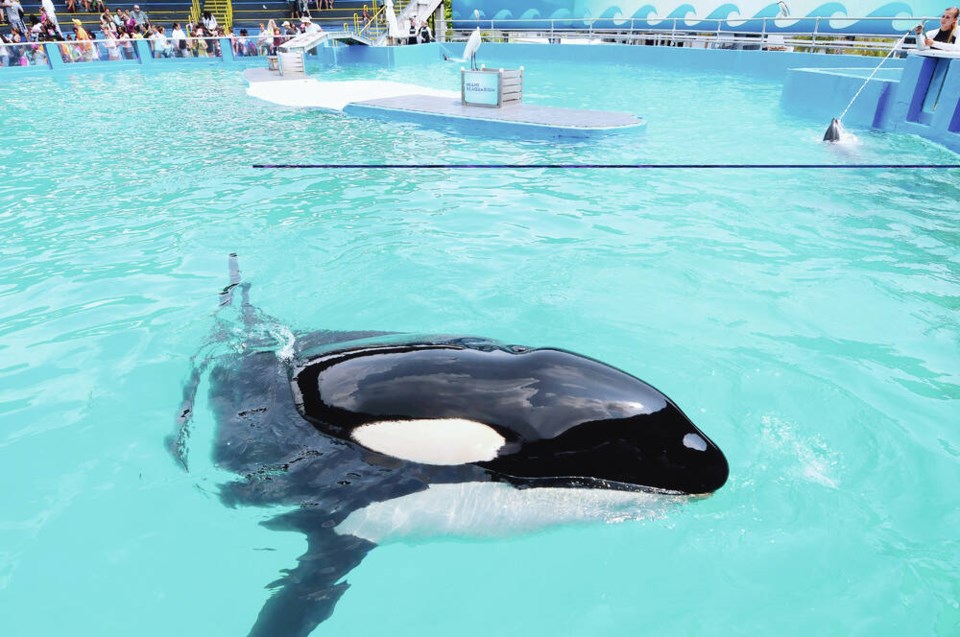A commentary by the author of The Killer Whale Who Changed the World and Orcas Everywhere.
As the sun set on Aug. 17, all three communities of the southern resident orcas gathered in the waters off the San Juan Islands. Their 95-year-old matriarch, Ocean Sun, swam alone nearby.
These superpod gatherings are incredibly rare and tend to coincide with births and deaths.
More than 5,000 kilometres away, the orca some believe to be Ocean Sun’s daughter was dying in her tank at the Miami Seaquarium.
The next day Tokitae, also known as Toki, Lolita and Sk’aliCh’elh-tenaut, died at 1 p.m. Pacific time, succumbing to suspected renal failure and 53 years in captivity — many of them in solitary confinement.
Despite her age, her death was a shock. A medical update issued by the Seaquarium three days earlier declared Toki’s health was “very stable and as good as she can be.”
She appeared to be clear to finally return home to a sea pen in the Salish Sea where she would be cared for, at least in part, by the Lhaq’temish (Lummi) people who consider her family and call her Sk’aliCh’elh-tenaut.
The last southern resident orca in captivity, Toki was one of roughly 50 orcas taken from the small community between 1965 and 1976 for display in aquariums around the world. Approximately 20 Bigg’s orcas — a different community and ecotype — were also taken.
On Aug. 8, 1970, Toki was captured along with about 90 other killer whales (as they were known at the time) at Penn Cove off Whidbey Island in Washington state by Seattle’s Namu Inc.
The orca hunters did not know they had netted a superpod — almost the entire southern resident population — or that this was a unique population.
Several orcas died in the capture. Three young orcas were sliced open and weighed down with rocks and anchors to hide the bodies. Toki was one of seven young orcas from that hunt who were sent to aquariums. The other six died by 1987.
When Toki arrived in Florida to breed with their male orca, Hugo, she was renamed Lolita. Hugo died of a brain aneurysm in 1980 after repeatedly slamming his head against the wall of their tank.
Toki hadn’t seen any other orcas since then.
The 20-foot-long, 7,000 pound whale lived in an 80-foot-long, 35-foot-wide tank — considered the world’s smallest. When The Dolphin Company bought the Seaquarium in 2021, the U.S. Department of Agriculture agreed to the sale on the condition that Tokitae stop performing.
She did. In 2022.
In March 2023, The Dolphin Company signed an agreement with a group called Friends of Toki to return the orca to the Salish Sea. The move would be bankrolled in large part by Indianapolis Colts owner, Jim Irsay, who committed $20 million to the project.
The southern resident community consists of three pods — J, K and L. Each has their own language and Toki’s calls identified her as a member of L-Pod.
It’s possible she’s the daughter of Ocean Sun but no DNA tests have been done to confirm this, though they could be. Howard Garrett, who runs Orca Network, has DNA from Ocean Sun but says Tokitae’s owners have never agreed to provide a sample to test it against.
Garrett’s late brother Ken Balcomb, founder of the Center for Whale Research, launched the campaign to bring Tokitae home in 1995. Garrett has worked for her return since then.
“She wasn’t just a circus animal. She was a member of the Southern residents,” Garrett told the Skaana podcast just after her death.
He’s hoping her legacy will raise awareness of the challenges facing her family, who are critically endangered because of the impact of losing almost a generation to captivity and the scarcity of their primary food source, chinook salmon.
“Toki’s legacy is building, building by the day.”
Tokitae is survived by the 75 remaining southern residents and the Lummi Nation. Responding to news of her death, Lummi Chair Tony Hillaire declared: “She is one of us. She is a Lummi leader.”
Sacred Sea – an Indigenous-led organization working to bring Toki home – issued a brief statement.
“Sk’aliCh’elh-tenaut (Tokitae / Lolita) has walked on. This was sudden and unexpected. Our grief is heavy. Right now, we have no words.”
Their vice-president, Lummi Elder Raynell Morris, who is on the board of Friends of Toki, went to Miami to request that her body be returned home for a proper burial.
In lieu of flowers, breach the Snake River dam and join campaigns that support the survival of chinook to keep Toki’s family alive.
>>> To comment on this article, write a letter to the editor: [email protected]



